|
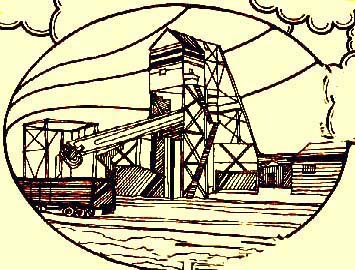
How did coal mining begin and
develop in Iowa?
The earliest settlers
mined coal among the hills of south central Iowa. They used coal to heat
their homes and cook their food in areas were timber was not available.
Not until 1870 did the industry of coal mining begin to rapidly
grow in Iowa. By that time the major Iowa railroads reached from the
Mississippi River in the east to the Missouri River in the west. The
railroads leased land in coal producing areas and operated mines which
produced coal for the use of the railroads. These were the largest and
most productive mines in the state.
Iowa coal mining grew rapidly from 1870 to 1920. The graph, "Coal
Production in Iowa, 1860 - 1938, " shows the decline of coal production
after 1920. Mining declined for several reasons. The railroads began
buying coal from other states such as Illinois and Kentucky. As a result,
the mining industry in Iowa was thrown into competition with the national
markets. In addition, Iowans began looking to other energy sources for
home use such as electricity, natural gas and fuel oil.
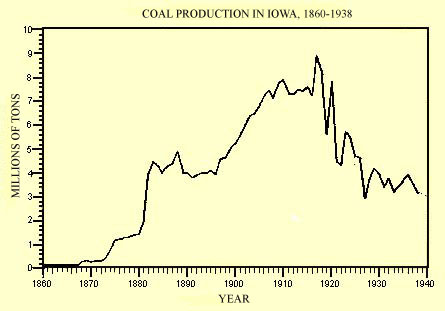
Source: Census of Iowa, 1905, p.IXXXIX;
Iowa Geographical Survey, Vol.XXXVII,
p. 465.
"A Mineral Map of Iowa"
(p.5) shows the areas where coal was located and mined. Coal deposits
could be found in much of central Iowa. The mining area however, extended
from Wapello County in southeastern Iowa to Boone County in central Iowa.
Throughout the mining area were dozens of coal camps which provided
housing for the coal mining families.
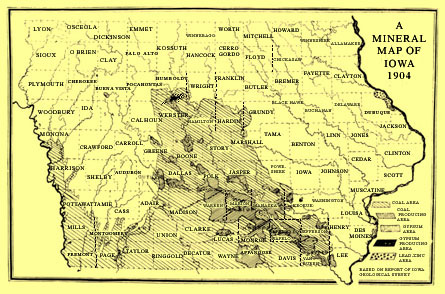
What was life like in a coal camp?
Usually a coal camp had
several hundred small homes, a company store, a tavern or pool hall, and a
school. Most coal companies required that miners shop only at the company
store which sold everything from "cradles to coffins." Most mining
families didn't like this restriction. Because the average coal mine
lasted only ten years, little care was given to the appearance of these
camps.
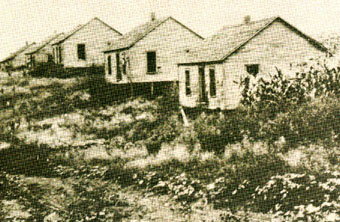
Coal mining camp houses about 1900. Location unknown
One of the best remembered and most unusual coal camps was located
in Monroe County in southern Iowa. Buxton, as it was called, was a
thriving coal community during the early 1900s.
At first the camp was located at what was called Muchakinock about
five miles south of Oskaloosa in, Mahaska County.
For at least two years mining was good in this area. But then in
1875 labor troubles began. The workers went on strike. In 1881 black
workers recruited from the south were hired as strike breakers. In a few
years the mines of Muchakinock were nearly exhausted. The Chicago and
Northwestern railroad, which owned the Consolidation Coal Company, bought
more land south in Monroe County. The community moved south where they
began to build the town of Buxton. It was named after J.E. Buxton, the
superintendent of the Consolidation Coal Company.
Buxton was a thriving community for at least twenty years. By 1920
the mines began to run out of coal. By 1927 the last mine was closed.
Buxton soon became a ghost town like the many other mining camps dotting
central Iowa.
Buxton was unique because of the highly developed community with
many businesses and public buildings. At its height, Buxton had black
doctors, lawyers, teachers, ministers, undertakers and pharmacists. It had
the largest industrial Y.M.C.A. in existence in the United States.
Buxton was also unique because of the long life it had in
comparison with other mining camps. The community had its beginnings at
Muchankinockin the 1870s and lasted until the late 1920s.
Mrs. Minnie B. London provides much interesting information about
Buxton in her account, As I Remember.
What was it like inside a coal
mine?
The best way to answer that question
would be to visit a mine. Since that may not be possible, the following
diagrams and materials may be helpful.
During the course of Iowa’s coal mining days, there were four main
methods for reaching the coal deposits. Figure 1 shows a comparison of
these methods.
Where the coal deposit lay horizontal and was visible from a
hillside, entry could be made directly into the coal deposit. This was
called a drift mine.
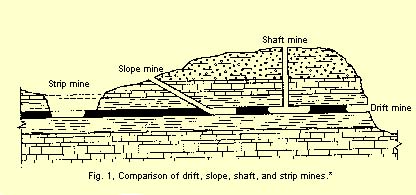
Where the coal deposit lay not more than a hundred feet from the
surface of the ground, a sloping tunnel could be cut to the coal. This was
called a slope mine.
Where the coal deposit was close to the surface and the layers
above could be easily removed, a strip mine was set up.
When the deposit was so deep that a slope would be difficult to
construct, a vertical shaft was sunk down to the coal deposit. From there
horizontal tunnels were cut into the deposit forming a room and pillar
mine. (see figure 2.)
A Tour Through An Albia Coal Company Mine provides an early
description of a room and pillar mine operation in Monroe County, 1878.

Fig. 2. Top view (plan) of a room and pillar mine.*
* Used by permission: Schwieder, Dorothy, Kraemer, Richard,
Iowa's Coal Mining Heritage,
The State of Iowa, 1973.
Explorations in Iowa History Project
Malcolm Price Laboratory School
University Of Northern Iowa
Cedar Falls, Iowa
©COPYRIGHT 2003 University of Northern Iowa
Lynn.Nielsen@uni.edu
Duplication for Instructional purposes only.
Credits: Logo and site design by ITS CET
Documents courtesy of the State Historical Society of Iowa
|





